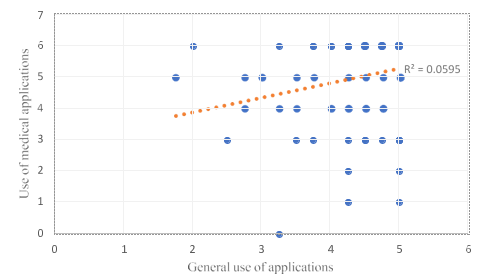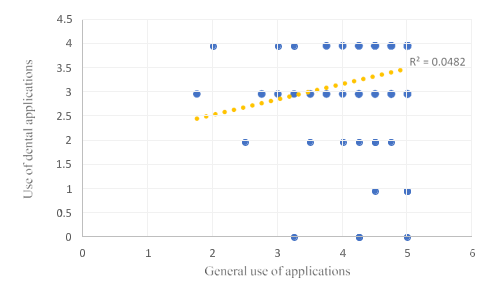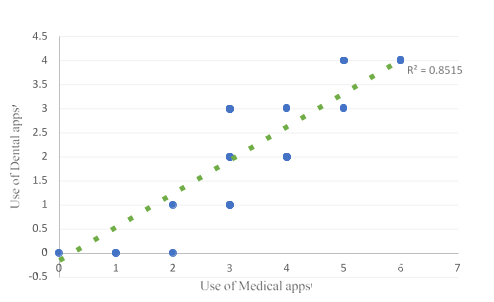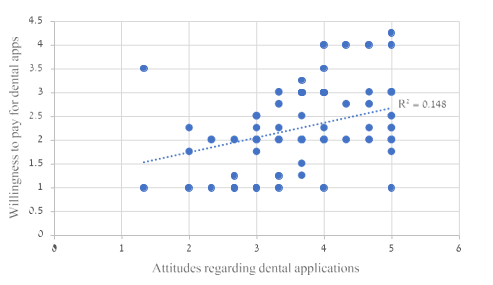Understanding Attitudes of the use of Dental Applications among Parents of Kindergarten Aged Children
Livny A1, Hasidim N2, Chackartchi T3, Mann J2, Haim D4, Vered Y2, Findler M4, Tobias G2*
1Hebrew University of Jerusalem, Faculty of Dental Medicine, Department of Prosthodontics, Hadassah Medical Center, Jerusalem, Israel
2Hebrew University of Jerusalem, Faculty of Dental Medicine, Department of Community Dentistry, Hadassah, Medical Center, Jerusalem, Israel
3Hebrew University of Jerusalem, Faculty of Dental Medicine, Department of Periodontology, Hadassah Medical Center, Jerusalem, Israel
4Dental Research Unit, Maccabi-Dent, Maccabi Healthcare Fund, Israel
*Corresponding author:Tobias Guy, Hebrew University of Jerusalem, Faculty of Dental Medicine, Department of Community Dentistry, Hadassah Medical Center, Jerusalem, Israel.
Received: January 05, 2024; Accepted: January 18, 2024; Published: January 30, 2024
Article Information
Citation: Livny Alon, Hasidim Noa, Chackartchi Tali, Mann Jonathan, Haim Doron, Vered Yuval, Findler Mordechal, Tobias Guy. Understanding Attitudes of the use of Dental Applications among Parents of Kindergarten Aged Children. Dental Research and Oral Health. 7 (2024): 23-29.
View / Download Pdf Share at FacebookAbstract
Introduction: Teledentistry refers to the use of telehealth systems and methods for remote dental examination, diagnosis, consultation, and treatment planning. Dental mobile applications can promote dental health to the public. Due to the fact that the attitudes of parents influence their young children, we investigated 3 hypotheses: 1) Parental attitudes regarding the use of dental apps will be positive for themselves and their children; 2) The attitude of the parent will be more positive for dental apps for their children than for themselves; 3) Parents with higher usage of medical apps, will have more positive attitudes to using dental apps and be more willing to pay for the service
Methods: This cross-sectional questionnaire-based study examined the attitude of parents regarding the use of dental apps. The anonymous questionnaire was distributed through social media in WhatsApp groups of parents with children aged 0-6 years in Israeli kindergartens and schools.
Results: The more apps a person uses in their daily life, the more medical and dental apps they utilize. Higher usage of dental apps improved attitudes towards these applications in the parent group (p<0.01). Positive attitudes increased willingness to pay for the applications (r=0.148, p<0.001).
Conclusion: Health apps change interactions with health care professionals, enabling remote access with doctors and dentists. Parents of young children had positive perceptions of the usefulness of applications as a tool to promote the oral health of their children.
Clinical implication: Further research and development of dental applications is required to improve and reduce dental diseases among young children.
Keywords
eHealth, Teledentistry, Willingness to pay, Health education, Health promotion
Article Details
Introduction
Untreated oral conditions such as tooth decay or severe periodontal disease, affect approximately 3.5 billion people worldwide. Oral diseases lead to unnecessary pain and suffering and are the fourth most expensive disease to treat in most industrialized countries in the world [1]. In addition, poor oral hygiene may have a negative impact on eating, smiling, speech and communication, due to discomfort or embarrassment [2].
Early childhood caries is a very common diseases and is not limited to children of low socioeconomic status and impacts upon both oral and general health [3]. Tooth decay leads to pain, orthodontic problems, enamel defects,
as well as disordered eating and speech, and an increased risk of tooth decay as adults. Caries has an impact on the children themselves, and the daily routine of their caregivers [4].
“eHealth”
eHealth refers to the developing field in medical sciences and public health, wherein health services and information are transmitted through the Internet and related technologies. In a broader sense, the term characterizes not only developing technology, but also to a way of thinking and approaching improvements to health services on a local, regional, and even global scale by means of information transfer and communication aided by technology [5].
Telehealth Monitoring and Telemedicine
Telehealth Monitoring refers to communication between patients and therapists facilitated by technology without the need for in-person appointments by bridging geographical gaps, Telehealth Monitoring enhances treatment accessibility and curtails the ancillary expenses associated with conventional clinical care, such as travel time, fuel costs, and parking fees, allowing consultations while the patient and care provider remain in their respective homes. Additionally, Telehealth Monitoring incentivizes individuals to seek care for non-urgent concerns that might otherwise be deferred due to challenges related to travel and scheduling. Telemedicine is a form of telehealth that refers to medical, diagnostic and treatment-related services that are provided remotely [6].
Teledentistry
Teledentistry is the use of telehealth systems and methodologies for dentistry, including patient care and education for better oral health. Communication can be through live video (i.e., synchronous), or transmission of recorded information (i.e., asynchronous) [7]. Remote patient monitoring (RPM) involves the remote collection of personal health data [8]. The term mHealth, where “m” is for mobile, is for public health measures that are supported by communication devices such as mobile phones, computers and personal digital assistants (PDA) [9]. Teledentistry has been found useful for remote dental examination, diagnosis, consultation, and treatment plan proposal. Furthermore, there are advantages to implementing this technology in areas with limited access to dental services, for school children and even for long-term dental treatments [10].
Mobile application use is rising in general, and this increase is also seen the field of medicine. Health apps can help people manage and improve their health and quality of life, promote a healthier lifestyle, and access essential information efficiently. Apps are currently available for weight loss, exercise, pregnancy tracking, and more [11].
Historically, examinations and consultations have always been performed in person (face-to-face), yet technological advances have enabled dentists to communicate with patients remotely. The American Dental Association-ADA stated that examinations using teledentistry can extend the reach of dental professionals and increase access to care by reducing the effects of distance barriers to care [12]. To achieve these improvements, teledentistry should be include a consistent way to establish a relationship between the patient and the care provider, while maintaining the personal nature of this relationship. The quality of examinations and treatments carried out using tele dentistry must be at least as good as those performed in person. For example, the dentist providing the service must ensure that the information collected is sufficient to make an accurate diagnosis and a treatment plan [8].
The covid-19 pandemic highlighted the necessity of this type of technology especially since the infection was spread by droplet contact, making dental treatments particularly risky. Tele dentistry allowed for routine follow-up, training, education, and referrals without direct face-to-face contact [13].
Uses of Tele Dentistry
To maintain oral health, the recommended oral hygiene routine includes, twice daily brushing, and regular visits to the clinic where the dentist checks for signs of dental and oral disease and provides instructions for proper oral hygiene [1].
Although these steps for oral health maintenance are well known, there is evidence that a significant percentage of the population does not perform them. Underwood et al. (2015); found that 33% of men do not brush their teeth twice a day, and 59% of women regularly skip brushing in the evening [14]. Dental mobile apps are a practical way to promote dental health to the public at a low cost, especially when considering that 77% of US citizens and 76% of the population in the State of Israel have a mobile device [15].
During the Covid-19 pandemic, there were times where it was impossible to carry out dental treatments in the traditional way [10], and this allowed the thorough examination of the degree of patient satisfaction with teledentistry in terms of ease of use and access to clinical services [11]. Those using the technology reported that their complaints and concerns were answered and noted that the technology is easy to use and saves time. A London study with 103 follow-up patients found that over half of the respondents preferred telephone reviews to face-to-face meetings.
Although there are some costs to practitioners adopting the technology, it reduces unnecessary appointments, and disparities in dental health. Waiting lists may also be shortened [17].
The influence of parent's influence on the oral health of their children:
Parents/primary care givers have the greatest influence on young children [18], and the acquisition of good hygiene habits in childhood contributes to adequate oral hygiene habits in adulthood. Factors such the education level of the parent, their occupation and health behavior are directly related to the health habits of the family. Healthy parents are more likely to have children with a better oral health than unhealthy parents, and the frequency of brushing among parents predicts the frequency of brushing in their children [19]. Furthermore, a direct relationship between the caries experience of the parent and the state of oral health in the child has been found [20]. There are various reasons for this connection e.g., neglect of oral health for financial services, may explain this relationship.
Dental anxiety – a challenge in dental treatments for children:
Dental anxiety, is a common in children and adolescents, with many consequences, for the staff, the child, and their family [21]. Treatment of individuals suffering from dental anxiety may take longer, consume considerable resources, and make it difficult for the dentist. Therefore, assessing the level of anxiety and identifying its causes before the child enters the clinic, can help control anxiety levels, and reduce negative behaviors during the treatment [22].
Using tele dentistry for child dental care:
Some of the advantages of telehealth for child dental care include greater accessibility, earlier diagnosis and treatment, reduced absence from work or school, avoidance of the stress related to the medical environment and encouraging continued care [23]. Tele dentistry is economically efficient, it facilitates high-quality primary screening and rapid diagnosis. The non- intrusive nature of this method is less stressful and improves the relationship between the treatment provider and the child in the treatment room [24].
The aim of this study was to examine the attitudes of parents of kindergarten children regarding the use of applications that encourage the promotion of oral health.
Materials and Methods
The questionnaires for this cross-sectional anonymous questionnaire-based study were distributed in WhatsApp groups of parents of children 6 years of age or younger in kindergarten or schools in Israel. Following approval of the Ethics Committee of the Hebrew University and the Hadassah Medical Center (number 12092021) managers of 20 WhatsApp groups with about 500 participants consented to sharing the questionnaire in their groups.
Inclusion criteria:
- Smart phone owners
- Parent of a child 0-6 years of age.
- Over the age of 18.
- Speak and read Hebrew.
The questionnaire had four parts: 1) General information (age, gender, marital status, etc.); 2) Personal app use, type and frequency of use; 3) Questions related to the promotion of oral health, referring to positions regarding the relationship between the contribution of apps to general and oral health; 4) Attitudes and willingness to paying for health apps.
Before distributing the questionnaire to the research population, a sample group of seven parents of children in the same age range were asked to answer the questions. This helped ensure that the questionnaire was unambiguous and had logical connections between the different parts.
The internal reliability of the questionnaire was tested according to Cronbach's alpha and was found to be high (α= .830).
Statistical methods
Data analysis was performed using SPSS software, version 28.0. The sample population was described according to socio-demographic variables based on the distribution of frequencies and percentages.
Center (average) and dispersion (standard deviation, minimum and maximum values) indices were used for the descriptive statistical tests. In addition, T-tests were conducted for paired samples, segmenting was based on who the app is for (parent/child). T-tests were also conducted for independent variables and segmenting was according to marital status of the parent (in a relationship/not). Pearson correlations were conducted for quantitative variables.
Results
The study population included 105 parents of children aged 0-6. The age range of the parents was 24 to 64 years, with an average of 37.91 (SD=8.12).
Most of the study population was female (81%), born in Israel (84%), had an academic degree (85%), and in a relationship (90%). The number of children per family ranged from 1 to 6 with an average of 2.23 children (SD=1.18).
Most of the questions were multiple choice, and more than one correct answer could be marked. The most common value regarding the question of the benefits of using a dental application for yourself was: "time saving" (33%), the most common value for the question of the benefits of this application for your children was: "It is important for me to be in control of their health" (32%).
Research hypothesis testing
Hypothesis 1: Parental attitudes regarding the use of dental apps will be positive for themselves and their children.
Statistically significant positive relationship between the variables (r=.433, p<.001) in hypothesis 1. The more the parents' use of dental apps increases, the more positive their attitudes will be for the use of dental apps.
Hypothesis 2: The attitude of the parent will be more positive for dental apps for their children than for themselves.
This hypothesis was confirmed and a statistically significant difference was found between parental preferences, apps intended for their children (M=2.24, SD=0.78) vs. apps for themselves (M=2.14, SD=0.77), {T (103)= - 1.786, p=.038}.
Hypothesis 3: Parents with higher usage of medical apps, will have more positive attitudes to using dental apps and be more willing to pay for the service.
Significant positive relationships were found between general use of apps and: use of medical apps (r=.244, p=.006) and use of dental apps (r=.219, p=.012). The more apps a person used in their day-to-day life, the more they used medical or dental app (see graphs 1 and 2).
A significant positive relationship was found between the use of medical and dental apps (r=.923, p<.001) see graph 3.
A significant positive relationship was found between willingness to pay for dental applications and attitudes regarding them (r=.148, p<.001); The more positive the parent was about app use, the more willing they were to pay for such apps (graph 4).
Discussion
In this cross-sectional study a questionnaire was distributed through WhatsApp groups of parents of children younger than 6 in school or kindergarten in Israel. The average age of the mostly female cohort was 38 years, and the most significant relative advantage reported by these young parents was the perception that using the app would save time, and this is congruous with the belief that one of the benefits of utilizing technological capabilities is optimal time management [25]. Traditional dental appointments at a clinic require time to make the appointment, changes in routine, travel to the clinic, finding parking etc. These inconvenient steps can be at the expense of work hours and sometimes require an additional person to supervise other children in the family. Studies have found that these issues lead to avoidance of going to the dentist until it is no longer possible to postpone the visit [26,27]. Tele dentistry offers a solution to most of the challenges presented, the option of transferring information and consulting with the dentist through a dental application has been found to increase responses to routine examinations and consultation calls, thereby lowering the clinical burden and increasing the satisfaction of both the patient and the therapist [28].
Many of the parents in the study cohort reported the importance they attach to verifying the health of their children, and indeed this concept has been reported [29,30], for example Losiouk et al. (2018) found that parents of young children state that one of the advantages of using medical apps is the benefit of continuous monitoring of their child's health.
All three study hypotheses were confirmed in a statistically significant way.
Hypothesis 1: parents would have a positive attitude towards the use of dental applications for themselves and their children was found to be correct. The widespread use of cell phones has led to the adoption of applications and their assimilation into our daily routines. Studies found that users install apps from different content areas, such as entertainment, business, apps to make routine tasks easier and health apps [5,31].
Some health apps (for non-health professionals) provide information using understandable language and others change the way we interact with health care professionals [32]. Current technology makes it possible contact doctors remotely, for consultation, follow-up, while maintaining the option of making an in-person appointment. Studies show that the more a person is exposed to these technologies, the better their opinion becomes regarding their use for themselves and their children [33,34].
Hypothesis 2: Parents of young children will have a more positive attitude towards using dental apps for their children than for themselves was also proven correct.
A possible explanation for this is that parents prioritize the welfare of their children over their own, and many adults differ their own needs until they can no longer ignore them, yet take care of their children’s less urgent concerns without delay [35].
The first step in the diagnostic process is data collection, readily available technologies allow the transfer of bio- information between patients and care providers without the need to be in the clinic, and this basic and reliable information helps assess the urgency of the case and where the person should go for appropriate treatment. Further investigation of why parents of young children have more positive perceptions about applications for their child’s heath than their own are warranted.
Hypothesis 3: The more the parent uses medical apps, the more positive their attitude towards dental apps, and the more willing they will be to pay for the service. Willingness to pay (WTP)– describes the amount a consumer is prepared to pay for a particular service or product. The more the consumer perceives that the technology promotes health, the more they will be inclined to pay for it [36]. Paying for a service is a way of expressing trust in the service. Our previous publication demonstrated that subjects who believed that mHealth apps can enhance health had a higher willingness to pay for the service [37].
Conclusion
Young parents have positive attitudes regarding dental apps, they believe they will improve the oral health of their children. They also seem to be willing to pay for this type of application.
Limitations
The main limitation of this study is the difficulty of generalizing the results, due to the possible selection bias of the participants. Firstly, most of the participants were females and their responses may not represent the opinions of all genders. These issues can be resolved using all genders groups with cohorts from different age groups. Another substantial limitation is the fact the study group was found using convenience sample methods, all participants were from WhatsApp social media groups in Israel that we were able to reach. The 21% response rate should be investigated. Although the response to online surveys rate are highly variable [38] they are usually in the 25-30% range.
References
- Kassebaum NJ, Smith AGC, Bernabé E, et GBD 2015 Oral Health Collaborators. Global, Regional, and National Prevalence, Incidence, and Disability-Adjusted Life Years for Oral Conditions for 195 Countries, 1990-2015: A Systematic Analysis for the Global Burden of Diseases, Injuries, and Risk Factors. J Dent Res 96 (2017): 380-387.
- Peres MA, Macpherson LMD, Weyant RJ, et al. Oral diseases: a global public health challenge. Lancet 394 (2019): 249-260.
- Seow WK. Early Childhood Caries. Pediatr Clin North Am 65 (2018): 941-954.
- Zaror C, Matamala-Santander A, Ferrer M, et al. Impact of early childhood caries on oral health-related quality of life: A systematic review and meta-analysis. Int J Dent Hyg 20 (2022): 120-135.
- Tobias G, Spanier Developing a Mobile App (iGAM) to promote gingival health by professional monitoring of dental selfies: user-centered design approach. JMIR Mhealth Uhealth 8 (2020): e19433.
- Burke BL Jr, Hall RW. Section on Telehealth Care. Telemedicine: Pediatric Applications. Pediatrics 136 (2015): e293-308.
- El Tantawi M, Lam WYH, Giraudeau N, et al. Teledentistry from research to practice: a tale of nineteen countries. Front Oral Health 4 (2023): 1188557.
- Farias FAC, Dagostini CM, Bicca YA, et al. Remote Patient Monitoring: A Systematic Review. Telemed J E Health 26 (2020): 576-583.
- Kruklitis R, Miller M, Valeriano L, et Applications of Remote Patient Monitoring. Prim Care 49 (2022): 543-555.
- Talla PK, Levin L, Glogauer M, et al. Delivering dental care as we emerge from the initial phase of the COVID-19 pandemic: teledentistry and face-to-face consultations in a new clinical Quintessence Int 51 (2020): 672-677.
- Ming LC, Untong N, Aliudin NA, et al. Mobile Health Apps on COVID-19 Launched in the Early Days of the Pandemic: Content Analysis and Review. JMIR Mhealth Uhealth 8 (2020): e19796.
- ADA Policy on Teledentistry (2023).
- Ghai S. Teledentistry during COVID-19 pandemic. Diabetes Metab Syndr 14 (2020): 933-935.
- Underwood B, Birdsall J, Kay The use of a mobile app to motivate evidence-based oral hygiene behaviour. Br Dent J 219 (2015): E2.
- Smartphone penetration as share of population in Israel 2019-2028.
- Ibraheim A, Sanalla A, Eyeson The role of teledentistry in oral surgery during the COVID-19 pandemic. Advances in Oral and Maxillofacial Surgery 1 (2021): 100005.
- Rahman N, Nathwani S, Kandiah Teledentistry from a patient perspective during the coronavirus pandemic. Br Dent J 14 (2020): 1-4.
- Chen L, Hong J, Xiong D, et al. Are parents' education levels associated with either their oral health knowledge or their children's oral health behaviors? A survey of 8446 families in Wuhan. BMC Oral Health 20 (2020): 203.
- Quek SJ, Sim YF, Lai B, et al. The effect of parenting styles on enforcement of oral health behaviours in children. Eur Arch Paediatr Dent 22 (2021): 83-92.
- Snell AK, Burgette JM, Weyant RJ, et al. Association between a child's caries experience and the mother's perception of her child's oral health status. J Am Dent Assoc 150 (2019): 540-548.
- Shindova MP, Belcheva AB. Dental fear and anxiety in children: a review of the environmental factors. Folia Med (Plovdiv) 63 (2021): 177-182.
- Roberts MW. Dental health of children: where we are today and remaining challenges. J Clin Pediatr Dent 32 (2008): 231-234.
- Sharma H, Suprabha BS, Rao A. Teledentistry and its applications in paediatric dentistry: A literature review. Pediatr Dent J 31 (2021): 203-215.
- Kopycka-Kedzierawski DT, Billings RJ, McConnochie Dental screening of preschool children using teledentistry: a feasibility study. Pediatr Dent 29 (2007): 209-213.
- Muschol J, Heinrich M, Heiss C, et Economic and environmental impact of digital health app video consultations in follow-up care for patients in orthopedic and trauma surgery in Germany: Randomized Controlled Trial. J Med Internet Res 24 (2022): e42839.
- Gragoll I, Schumann L, Neubauer M, et al. Healthcare avoidance: a qualitative study of dental care avoidance in Germany in terms of emergent behaviours and characteristics. BMC Oral Health 1 (2021): 563.
- Mittal R, Wong ML, Koh GC, et al. Factors affecting dental service utilisation among older Singaporeans eligible for subsidized dental care - a qualitative study. BMC Public Health 19 (2019): 1075.
- Islam MRR, Islam R, Ferdous S, et al. Teledentistry as an effective tool for the communication improvement between dentists and patients: An Overview. Healthcare (Basel). 10 (2022): 1586.
- Wainer AL, Arnold ZE, Leonczyk C, et Examining a stepped-care telehealth program for parents of young children with autism: a proof-of-concept trial. Mol Autism 12 (2021): 32.
- Losiouk E, Lanzola G, Del Favero S, et al. Parental evaluation of a telemonitoring service for children with Type 1 J Telemed Telecare 24 (2018): 230-237.
- https://www.statista.com/statistics/276623/number-of- apps-available-in-leading-app-stores/
- Kim H, Xie B. Health literacy in the eHealth era: A systematic review of the literature. Patient Educ Couns 100 (2017): 1073-1082.
- Nguyen M, Waller M, Pandya A, Portnoy A Review of Patient and Provider Satisfaction with Telemedicine. Curr Allergy Asthma Rep 20 (2020): 72.
- Vosburg RW, Robinson KA. Telemedicine in Primary Care During the COVID-19 Pandemic: Provider and Patient Satisfaction Examined. Telemed J E Health 28 (2022): 167-175.
- McKinley CE, Lilly J, Liddell JL, et "I Have to Watch Them Closely": Native American Parenting Practice and Philosophies. J Child Fam Stud 30 (2021): 2952-2965.
- Lee J, Oh Y, Kim M, et al. Willingness to use and pay for digital health care services according to 4 scenarios: Results from a national JMIR Mhealth Uhealth 11 (2023): e40834.
- Tobias G, Sgan-Cohen H, Spanier AB, et al. Perceptions and attitudes toward the use of a mobile health app for remote monitoring of gingivitis and willingness to pay for mobile health apps (Part 3): Mixed methods study. JMIR Form Res 5 (2021): e26125.
- Menon V, Muraleedharan A. Internet-based surveys: relevance, methodological considerations and troubleshooting strategies. Gen Psychiatr 33 (2020):






 Impact Factor: * 3.1
Impact Factor: * 3.1 Acceptance Rate: 76.66%
Acceptance Rate: 76.66%  Time to first decision: 10.4 days
Time to first decision: 10.4 days  Time from article received to acceptance: 2-3 weeks
Time from article received to acceptance: 2-3 weeks 